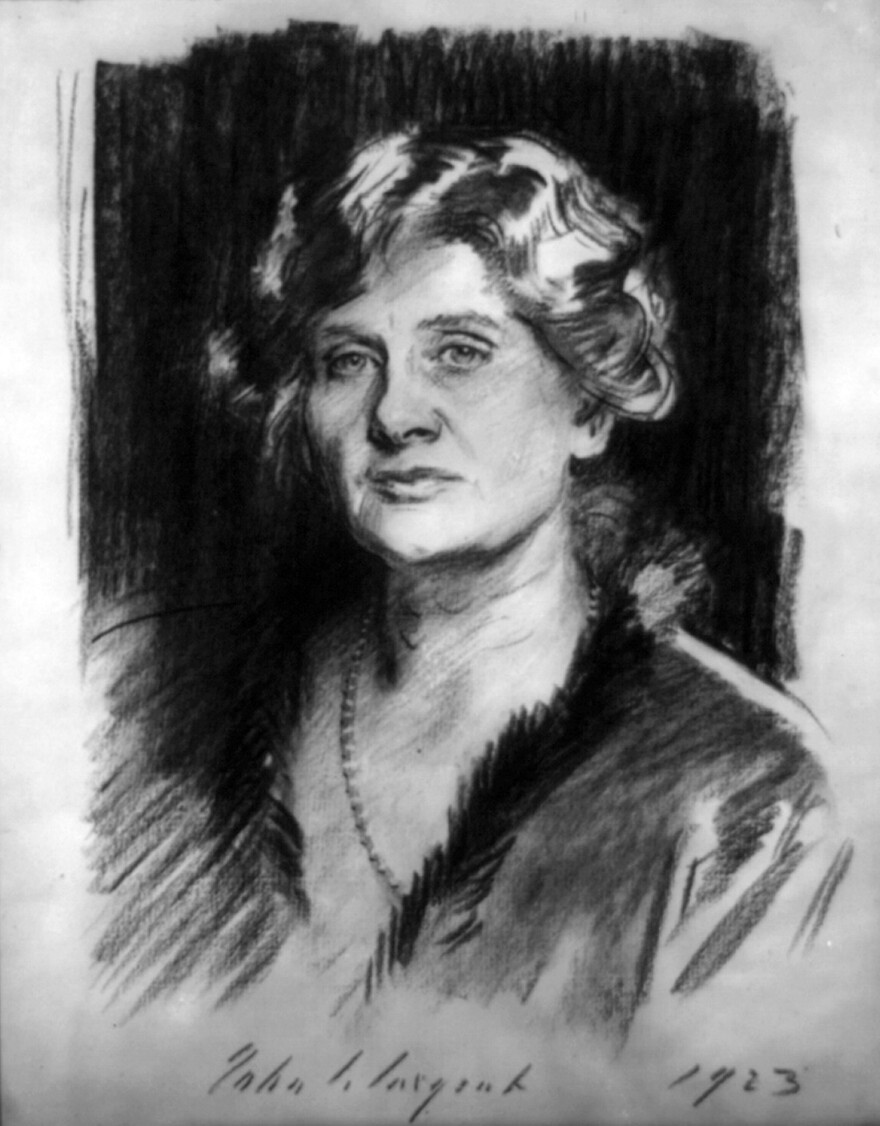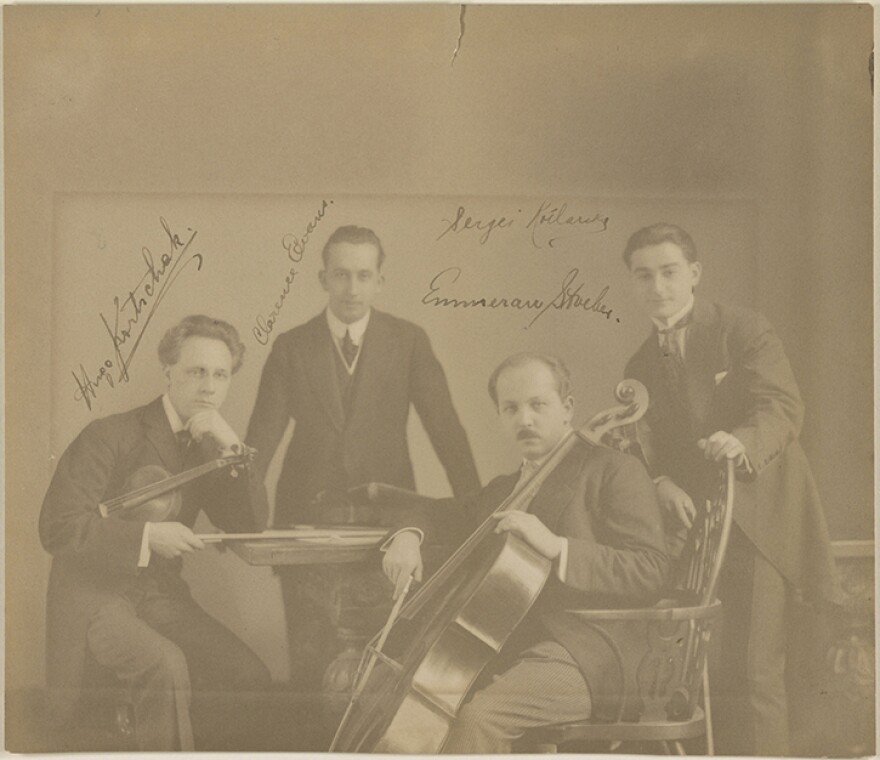Prefer to listen to this story? Hear Chris Voss read it in the audio player above.
Dotted throughout the more than 500 acres of Tanglewood are monuments to the great men who molded the venue into the pillar of musical excellence that it is - men who are literally memorialized in stone, like Leonard Bernstein, Serge Koussevitzky, and Aaron Copland, not to mention an entire concert hall named for Seiji Ozawa.
But less celebrated among the halls and statuary of Tanglewood are the women who, through great vision, great determination, and (let’s be honest) great personal wealth helped forge Berkshire County into a must-visit arts retreat, with Tanglewood chief among its attractions. They were women of a league and temperament with Isabella Stewart Gardner, Amelia Earhart, and Eleanor Roosevelt. Here is an introduction to just two of them.
Gertrude Robinson Smith (1881-1963)
Born into a wealthy, upper-crust New York City family, Gertrude Robinson Smith came to the Berkshires as a consequence of World War I, when her family was no longer able to summer in Paris as they normally had. As consolation, they built an estate in idyllic Stockbridge, Mass.
Not too bad.
Gertrude was not one to twiddle her thumbs in a pastoral paradise while others fought, however. No, as the war raged on, she set herself to organizing medical relief efforts, in particular raising $70,000 for ambulances. The vehicles secured, she then sailed with them to France and delivered them (and a mountain of other medical supplies) personally, at one point going so far as to fly over the front lines in a rickety bi-plane, dropping supplies down to soldiers in need, and taking aerial photographs of the front along the way.
Historians of the flowering of feminism have unjustly ignored Gertrude Robinson Smith, as determined, dynamic and purposeful a champion of female independence as ever asserted herself.Herbert Kupferberg
Demure and shrinking she was not.
Upon returning to the States , she also returned to the society duties expected of her, running clubs and various charitable organizations in both New York and the Berkshires. But after the intensity of raising money and delivering supplies for the war, one could imagine she was a little bored. I mean, in 1919 she built her own home – like threw-on-some-overalls-grabbed-a-hammer-and-some-nails-and-a-saw built her own home – in Stockbridge. The woman loved projects.
Then, in May of 1934, a big one came to her. The New York Philharmonic’s Associate Conductor Henry Hadley was driving around the Berkshires looking for ideal spots to realize his dream of a moonlit summer orchestral concert series. He’d found a spot, a horse ring, actually, at the Hanna Farm, and was asking around for people to help him get this thing off the ground.
Everyone said, “talk to Miss Robinson Smith.”

Robinson Smith immediately set herself to making the Berkshire Symphonic Festival a reality. In just three short months, she organized dozens of locals to raise funds, advertise, and even summon a choir from residents of every city and town in the Berkshires. And, by the time 65 members of the New York Philharmonic arrived to play a concert under an August full moon, 5,000 well-dressed, fully ticketed concert goers - including the Governor of Massachusetts and the mother of the President of United States - were there, too.
The Berkshire Symphonic Festival was off to the races (pun intended).
Robinson Smith’s involvement didn’t end with those first few concerts, though – not by a long shot! It was Robinson Smith who approached the Boston Symphony’s music director, Serge Koussevitzky, to bring his orchestra into permanent summer residence for the festival in Stockbridge after the New York Philharmonic declined.
It was also Robinson Smith who facilitated the building of Tanglewood’s most prominent structure: the Shed. During a particularly vicious, though not uncommon, downpour at Tanglewood, Robinson Smith bounded onto the soggy stage at intermission and declared that they couldn’t keep doing this thing in a tent. They needed a permanent venue. She raised $30,000 for it that night, and an additional $60,000 in the following months. By the following season, the Shed (later named for Koussevitzky) was completed, under budget and ahead of schedule.
Long story short: Gertrude Robinson Smith was an incredible woman, and it is to her that Tanglewood owes its existence. As Herbert Kupferberg writes in his 1976 book Tanglewood, “The prim, modest plaque that commemorates her at the entrance of the Tanglewood Shed hardly seems to measure the force of her achievements or her personality.”
(By the way, the festival moved to its current grounds on the Lenox-Stockbridge line in 1937, when the Tanglewood grounds were donated to the festival by another pair of women – a Mrs. Rosamund Dixey Brooks Hepburn and a Miss Mary Aspinwall Tappan – whose family had owned the property since the 1840s. Nathanial Hawthorne, of all people, gave the spot its name.)
Elizabeth Sprague Coolidge (1864-1953)
Before there was Tanglewood, before there was Gertrude Robinson Smith, before Henry Hadley had ever traveled to the Berkshires, there was Elizabeth Sprague Coolidge and her Berkshire Chamber Music Festival.
Coolidge came to the Berkshires by way of her husband, who moved his family from Chicago to Pittsfield in 1915 for his health. Sadly, he passed shortly thereafter, followed in quick succession by her parents, and Elizabeth found herself heartbroken, and outrageously wealthy. Her solution was to pour her inherited finances into philanthropy, most notably in support of music.

Coolidge came by her passion for music naturally. She was a highly trained and accomplished pianist — and even sometime composer (see below) — who had fallen in love with music festivals in Europe as a young socialite on her Grand Tour. But Coolidge was also a victim of the Gilded Age’s attitudes toward society women and the arts. It was not her place to make the art, but rather to facilitate the art.
And so she did.
In 1916 she formed the Berkshire Quartet, culled from the ranks of the Chicago Symphony. Two years later, she formed the Berkshire Chamber Music Festival on South Mountain in Pittsfield, building a venue she dubbed ‘The Temple of Music.’ The festival ran annually until 1924, and then intermittently until 1938.

More impressive than the festival, however, was her dedication to commissioning music — 1,284 works in all! Iconic works like Aaron Copland’s Appalachian Spring and Ottorino Resphighi’s Three Botticelli Pictures, as well as quartets by Benjamin Britten, Béla Bartók, Sergei Prokofiev, and Arnold Schoenberg (to name the most famous few), all exist because of Elizabeth Sprague Coolidge. And many of those had their premieres at her festival.
Additionally, she created the Berkshire Prize to accompany her festival, a composition prize that was sought after world over.
She was, as the plaque on the Temple of Music reads today, the “Fairy Godmother of Chamber Music” in the U.S.
And so, what does this have to do with Tanglewood? Well, she might well have asked the same question; despite initially supporting the venture and even being named honorary President of the festival’s first season in 1934, she lamented that it overshadowed and conflicted with her own festival, and ultimately withdrew her support in 1938.
But her own feelings aside, there is no doubt that without Elizabeth Sprague Coolidge, her festival, and her commissions, the simple idea that the Berkshires should be the place where a summer orchestral music festival could thrive might never have occurred to the likes of Henry Hadley or Gertrude Robinson Smith.
In other words, Elizabeth Sprague Coolidge built the foundation on which Tanglewood continues to reside.
Off-topic note of curiosity: Another great cultural institution in the Berkshires is the Massachusetts Museum of Contemporary Art, or MassMoCA, housed in the old Sprague Electric facility in North Adams, MA. I was hoping there was a connection between that Sprague and this one, but it appears the only connection is coincidence.



